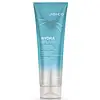What's inside
What's inside
 Key Ingredients
Key Ingredients

No key ingredients
 Benefits
Benefits

 Concerns
Concerns

 Ingredients Side-by-side
Ingredients Side-by-side

Water
Skin ConditioningCetearyl Alcohol
EmollientBehentrimonium Chloride
PreservativeIsopropyl Palmitate
EmollientStearyl Alcohol
EmollientPropylene Glycol
HumectantPhenoxyethanol
PreservativeEthylhexyl Olivate
Skin ConditioningCocos Nucifera Oil
MaskingHelianthus Annuus Seed Oil
EmollientRosa Canina Fruit Oil
EmollientLaurdimonium Hydroxypropyl Hydrolyzed Keratin
Skin ConditioningPhosphatidylcholine
EmulsifyingArginine Hcl
Skin ConditioningHydrolyzed Algin
Sea Water
HumectantChlorella Vulgaris Extract
Skin ConditioningDipropylene Glycol
HumectantCetyl Esters
EmollientHydroxyethylcellulose
Emulsion StabilisingBisamino PEG/PPG-41/3 Aminoethyl Pg-Propyl Dimethicone
Carthamus Tinctorius Seed Oil
MaskingGuar Hydroxypropyltrimonium Chloride
Skin ConditioningPolyquaternium-37
Isostearyl Ethylimidazolinium Ethosulfate
Tetrasodium Glutamate Diacetate
Propylene Glycol Dicaprylate/Dicaprate
EmollientPEG-4 Laurate
EmulsifyingPEG-14m
Emulsion StabilisingStyrene/Butadiene Copolymer
Squalane
EmollientCitric Acid
BufferingPPG-1 Trideceth-6
Skin ConditioningIsopropyl Alcohol
SolventSodium Hydroxide
BufferingIodopropynyl Butylcarbamate
PreservativeSodium Benzoate
MaskingPotassium Sorbate
PreservativeLinalool
PerfumingLimonene
PerfumingParfum
MaskingCI 42090
Cosmetic ColorantCI 60730
Cosmetic ColorantCI 19140
Cosmetic ColorantWater, Cetearyl Alcohol, Behentrimonium Chloride, Isopropyl Palmitate, Stearyl Alcohol, Propylene Glycol, Phenoxyethanol, Ethylhexyl Olivate, Cocos Nucifera Oil, Helianthus Annuus Seed Oil, Rosa Canina Fruit Oil, Laurdimonium Hydroxypropyl Hydrolyzed Keratin, Phosphatidylcholine, Arginine Hcl, Hydrolyzed Algin, Sea Water, Chlorella Vulgaris Extract, Dipropylene Glycol, Cetyl Esters, Hydroxyethylcellulose, Bisamino PEG/PPG-41/3 Aminoethyl Pg-Propyl Dimethicone, Carthamus Tinctorius Seed Oil, Guar Hydroxypropyltrimonium Chloride, Polyquaternium-37, Isostearyl Ethylimidazolinium Ethosulfate, Tetrasodium Glutamate Diacetate, Propylene Glycol Dicaprylate/Dicaprate, PEG-4 Laurate, PEG-14m, Styrene/Butadiene Copolymer, Squalane, Citric Acid, PPG-1 Trideceth-6, Isopropyl Alcohol, Sodium Hydroxide, Iodopropynyl Butylcarbamate, Sodium Benzoate, Potassium Sorbate, Linalool, Limonene, Parfum, CI 42090, CI 60730, CI 19140
Water
Skin ConditioningSodium C14-16 Olefin Sulfonate
CleansingDisodium Laureth Sulfosuccinate
CleansingDisodium Cocoamphodiacetate
CleansingSodium Chloride
MaskingGlycol Distearate
EmollientAmodimethicone
Sodium Lauryl Sulfoacetate
CleansingPPG-5-Ceteth-20
EmulsifyingPotato Starch Modified
Cocamide Mipa
EmulsifyingCeramide NP
Skin ConditioningCeramide AP
Skin ConditioningCeramide EOP
Skin ConditioningCarbomer
Emulsion StabilisingNiacinamide
SmoothingTrideceth-6
EmulsifyingTriethyl Citrate
MaskingSodium Hydroxide
BufferingSodium Benzoate
MaskingSodium Lauroyl Lactylate
EmulsifyingSalicylic Acid
MaskingSodium Hyaluronate
HumectantCholesterol
EmollientCoco-Betaine
CleansingCitric Acid
BufferingCetrimonium Chloride
AntimicrobialCaprylyl Glycol
EmollientPhytosphingosine
Skin ConditioningXanthan Gum
EmulsifyingPolyquaternium-10
Acrylates Copolymer
Benzoic Acid
MaskingWater, Sodium C14-16 Olefin Sulfonate, Disodium Laureth Sulfosuccinate, Disodium Cocoamphodiacetate, Sodium Chloride, Glycol Distearate, Amodimethicone, Sodium Lauryl Sulfoacetate, PPG-5-Ceteth-20, Potato Starch Modified, Cocamide Mipa, Ceramide NP, Ceramide AP, Ceramide EOP, Carbomer, Niacinamide, Trideceth-6, Triethyl Citrate, Sodium Hydroxide, Sodium Benzoate, Sodium Lauroyl Lactylate, Salicylic Acid, Sodium Hyaluronate, Cholesterol, Coco-Betaine, Citric Acid, Cetrimonium Chloride, Caprylyl Glycol, Phytosphingosine, Xanthan Gum, Polyquaternium-10, Acrylates Copolymer, Benzoic Acid
 Reviews
Reviews

Ingredients Explained
These ingredients are found in both products.
Ingredients higher up in an ingredient list are typically present in a larger amount.
Citric Acid is an alpha hydroxy acid (AHA) naturally found in citrus fruits like oranges, lemons, and limes.
Like other AHAs, citric acid can exfoliate skin by breaking down the bonds that hold dead skin cells together. This helps reveal smoother and brighter skin underneath.
However, this exfoliating effect only happens at high concentrations (20%) which can be hard to find in cosmetic products.
Due to this, citric acid is usually included in small amounts as a pH adjuster. This helps keep products slightly more acidic and compatible with skin's natural pH.
In skincare formulas, citric acid can:
While it can provide some skin benefits, research shows lactic acid and glycolic acid are generally more effective and less irritating exfoliants.
Most citric acid used in skincare today is made by fermenting sugars (usually from molasses). This synthetic version is identical to the natural citrus form but easier to stabilize and use in formulations.
Read more about some other popular AHA's here:
Learn more about Citric AcidSodium Benzoate is a preservative. It's used in both cosmetic and food products to inhibit the growth of mold and bacteria. It is typically produced synthetically.
Both the US FDA and EU Health Committee have approved the use of sodium benzoate. In the US, levels of 0.1% (of the total product) are allowed.
Sodium benzoate works as a preservative by inhibiting the growth of bacteria inside of cells. It prevents the cell from fermenting a type of sugar using an enzyme called phosphofructokinase.
It is the salt of benzoic acid. Foods containing sodium benzoate include soda, salad dressings, condiments, fruit juices, wines, and snack foods.
Studies for using ascorbic acid and sodium benzoate in cosmetics are lacking, especially in skincare routines with multiple steps.
We always recommend speaking with a professional, such as a dermatologist, if you have any concerns.
Learn more about Sodium BenzoateSodium Hydroxide is also known as lye or caustic soda. It is used to adjust the pH of products; many ingredients require a specific pH to be effective.
In small amounts, sodium hydroxide is considered safe to use. However, large amounts may cause chemical burns due to its high alkaline.
Your skin has a natural pH and acid mantle. This acid mantle helps prevent harmful bacteria from breaking through. The acid mantle also helps keep your skin hydrated.
"Alkaline" refers to a high pH level. A low pH level would be considered acidic.
Learn more about Sodium HydroxideWater. It's the most common cosmetic ingredient of all. You'll usually see it at the top of ingredient lists, meaning that it makes up the largest part of the product.
So why is it so popular? Water most often acts as a solvent - this means that it helps dissolve other ingredients into the formulation.
You'll also recognize water as that liquid we all need to stay alive. If you see this, drink a glass of water. Stay hydrated!
Learn more about Water